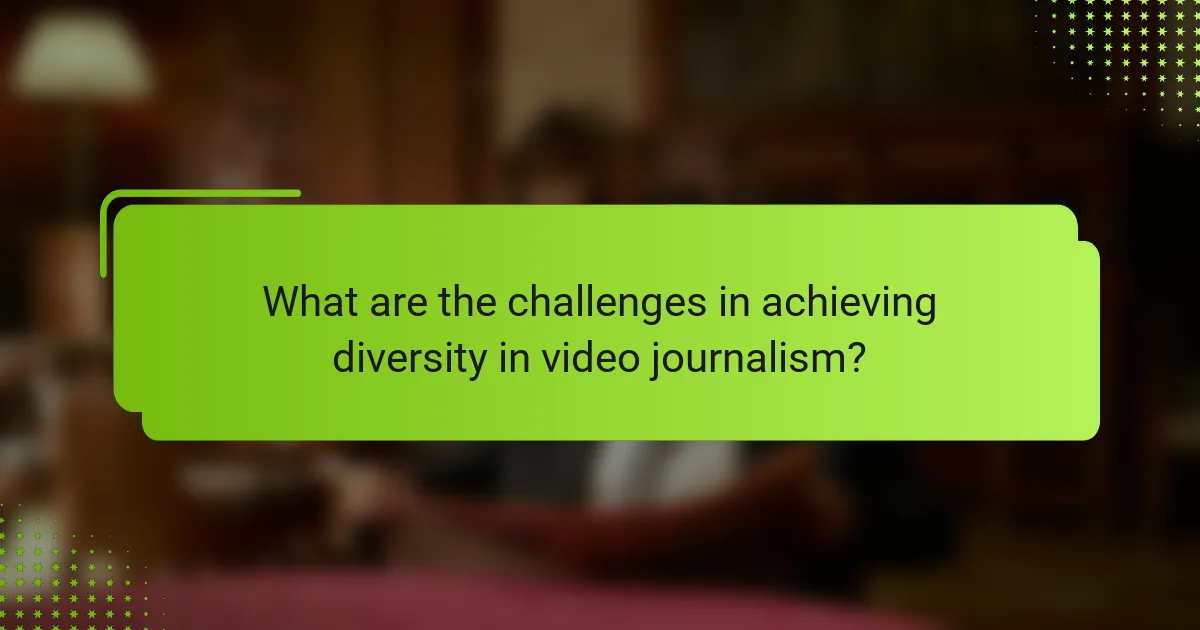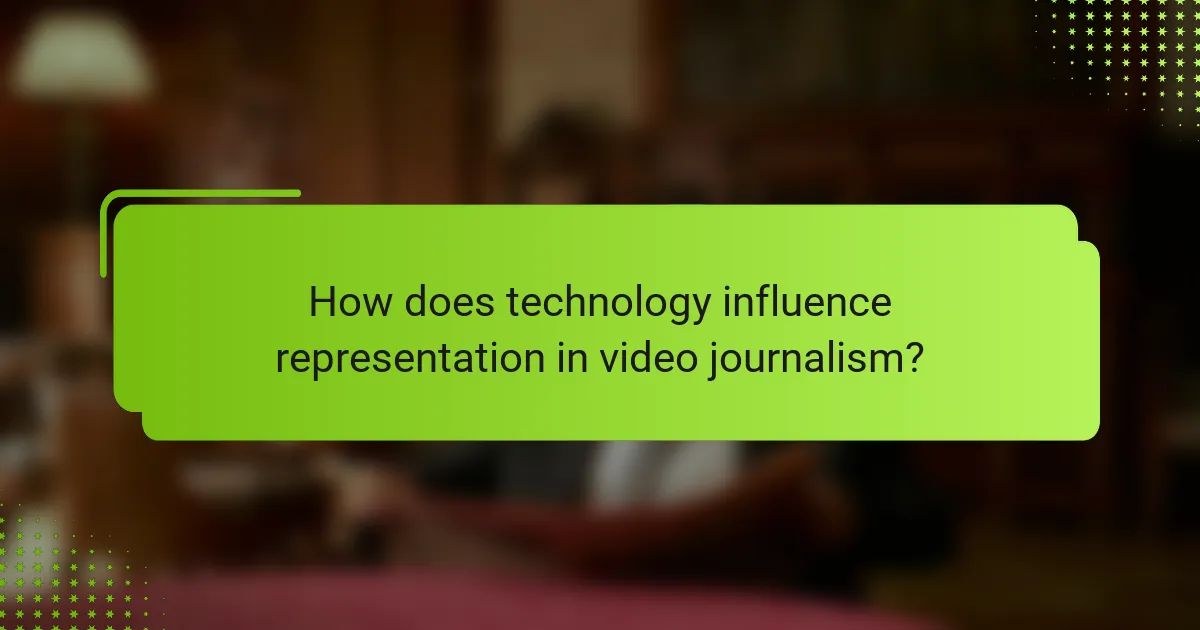Diverse perspectives in video journalism play a crucial role in shaping narratives and influencing audience perceptions in the UK. By amplifying varied voices, this approach not only enhances authenticity but also fosters inclusivity, ultimately reshaping public understanding and challenging stereotypes. Engaging with diverse communities allows video journalists to create content that reflects a broader spectrum of experiences and insights.

How does representation impact video journalism in the UK?
Representation in video journalism significantly influences how stories are told and perceived in the UK. Diverse voices and perspectives can enhance the authenticity and relatability of content, leading to a more engaged audience.
Increased audience engagement
When video journalism reflects a range of voices, it resonates more with diverse audiences. This connection can lead to higher viewership and interaction rates, as people are more likely to engage with content that reflects their experiences and backgrounds.
For example, including stories from underrepresented communities can attract viewers who feel seen and heard. This can result in increased shares and discussions on social media platforms, amplifying the reach of the content.
Diverse storytelling perspectives
Diverse storytelling perspectives enrich video journalism by providing a broader understanding of issues. Different cultural backgrounds and experiences can highlight unique angles on stories, fostering empathy and awareness among viewers.
In practice, this means incorporating various voices in interviews, using diverse sources, and presenting multifaceted narratives. Journalists should actively seek out stories that challenge dominant narratives, ensuring a more comprehensive portrayal of events and issues in society.

What are the key insights from diverse video journalism?
Diverse video journalism offers critical insights by amplifying varied perspectives and fostering inclusivity in storytelling. It emphasizes the importance of representation, which can reshape public understanding and challenge preconceived notions.
Highlighting underrepresented voices
Highlighting underrepresented voices is essential for creating a more balanced media landscape. This approach ensures that stories from marginalized communities are told authentically, allowing for a richer narrative that reflects society’s diversity.
For instance, video journalism that features interviews with local activists or community leaders can provide firsthand accounts of issues affecting their neighborhoods. This not only empowers these individuals but also educates viewers about different cultural contexts and challenges.
Challenging mainstream narratives
Diverse video journalism plays a crucial role in challenging mainstream narratives that often overlook or misrepresent certain groups. By presenting alternative viewpoints, it encourages critical thinking and fosters dialogue around complex social issues.
For example, a documentary that explores the impact of gentrification from the perspective of long-time residents can disrupt the dominant narrative that often favors developers. This approach invites viewers to reconsider their assumptions and understand the broader implications of such changes.

How can video journalists improve representation?
Video journalists can enhance representation by actively engaging with diverse communities and ensuring their narratives reflect a wide range of perspectives. This involves building relationships, understanding cultural contexts, and prioritizing inclusivity in storytelling.
Utilizing community partnerships
Establishing partnerships with local organizations and community leaders can significantly improve representation in video journalism. These collaborations provide journalists with insights into the community’s values, challenges, and stories that may otherwise be overlooked.
For effective partnerships, journalists should seek out community groups that represent various demographics, including race, gender, and socioeconomic status. Regular meetings and open dialogues can foster trust and ensure that the content produced resonates with the community.
Training on cultural sensitivity
Cultural sensitivity training is crucial for video journalists to navigate diverse narratives respectfully. This training helps journalists understand cultural nuances and avoid stereotypes, leading to more authentic storytelling.
Workshops can cover topics such as historical context, language use, and the impact of media representation on different communities. Journalists should also practice active listening and be open to feedback from the communities they cover, ensuring that their work is both accurate and respectful.

What are the challenges in achieving diversity in video journalism?
Achieving diversity in video journalism faces several significant challenges, including resource limitations and bias in editorial decisions. These factors can hinder the representation of varied perspectives and voices, ultimately affecting the quality and impact of journalism.
Resource limitations
Resource limitations are a critical barrier to achieving diversity in video journalism. Many news organizations operate with tight budgets, which can restrict their ability to hire a diverse workforce or invest in training programs that promote inclusivity. This often results in a lack of representation in storytelling and coverage.
For example, smaller media outlets may struggle to allocate funds for outreach initiatives that connect with underrepresented communities. As a result, they miss opportunities to include diverse voices in their reporting, which can lead to a narrow perspective on important issues.
Bias in editorial decisions
Bias in editorial decisions can significantly impact diversity in video journalism. Editors and decision-makers may unconsciously favor stories that align with their own experiences or viewpoints, leading to a lack of coverage on topics relevant to diverse audiences. This bias can perpetuate stereotypes and limit the scope of narratives presented to the public.
To counteract this, organizations should implement training on unconscious bias for their editorial teams and establish diverse editorial boards. These steps can help ensure that a variety of perspectives are considered in the decision-making process, ultimately enriching the content produced.

What frameworks support diverse perspectives in video journalism?
Diverse perspectives in video journalism are supported by frameworks that emphasize inclusive storytelling and ethical reporting. These frameworks guide journalists in representing various voices and experiences, ensuring a richer narrative landscape.
Inclusive storytelling guidelines
Inclusive storytelling guidelines focus on representing a wide range of voices and experiences in video journalism. This involves actively seeking out and incorporating perspectives from marginalized communities, ensuring that their stories are told authentically and respectfully.
Key steps include conducting thorough research to understand the cultural context of the subjects, using appropriate language, and avoiding stereotypes. Journalists should engage with the communities they represent, allowing them to contribute to the narrative and ensuring their viewpoints are accurately portrayed.
Ethical reporting standards
Ethical reporting standards are crucial for maintaining integrity and trust in video journalism. These standards emphasize accuracy, fairness, and accountability, guiding journalists to report responsibly and sensitively on diverse issues.
Practically, this means verifying information before publication, respecting the privacy of individuals, and obtaining informed consent when sharing personal stories. Journalists should also be aware of the potential impact of their work on the communities they cover, striving to avoid harm and promote understanding.

How does technology influence representation in video journalism?
Technology significantly shapes representation in video journalism by providing tools that enhance storytelling and broaden access to diverse voices. It enables journalists to capture and share a wider range of perspectives, ensuring that underrepresented communities can tell their own stories.
Access to diverse platforms
The rise of digital platforms has transformed how video journalism is disseminated, allowing for greater representation of various communities. Platforms like YouTube, Vimeo, and social media enable creators from different backgrounds to share their narratives directly with audiences, bypassing traditional gatekeepers.
These platforms often have user-friendly interfaces and support for mobile devices, making it easier for individuals to produce and upload content. However, the challenge remains in ensuring visibility amidst the vast amount of content available online.
Emerging tools for content creation
New tools for content creation, such as mobile editing apps and affordable cameras, empower a broader range of storytellers to produce high-quality video journalism. These technologies lower the barriers to entry, allowing diverse voices to emerge in the media landscape.
For instance, apps like Adobe Premiere Rush and Filmora offer intuitive editing features that can be learned quickly. Creators can produce compelling content without needing extensive training or expensive equipment, fostering a more inclusive environment for video journalism.

What are the future trends in diverse video journalism?
Future trends in diverse video journalism include the integration of advanced technologies and the rise of grassroots reporting. These developments aim to enhance representation and provide a broader range of insights into various communities.
Increased use of AI for representation
The application of artificial intelligence in video journalism is set to expand, enabling more accurate representation of diverse voices. AI tools can analyze vast amounts of data to identify underrepresented groups and highlight their stories, ensuring a more inclusive narrative.
For instance, AI algorithms can assist in content curation, suggesting topics that resonate with diverse audiences. However, journalists must remain vigilant about the ethical implications of AI, ensuring that it does not perpetuate biases or misrepresent communities.
Growth of citizen journalism
Citizen journalism is gaining momentum as more individuals leverage smartphones and social media to share their perspectives. This trend democratizes news reporting, allowing marginalized voices to contribute to the media landscape.
While citizen journalism can enrich the diversity of stories, it also presents challenges regarding credibility and fact-checking. Journalists should consider collaborating with citizen reporters to verify information and maintain journalistic standards, fostering a more reliable and inclusive media environment.



